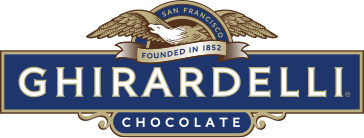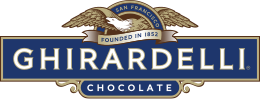Product FAQs
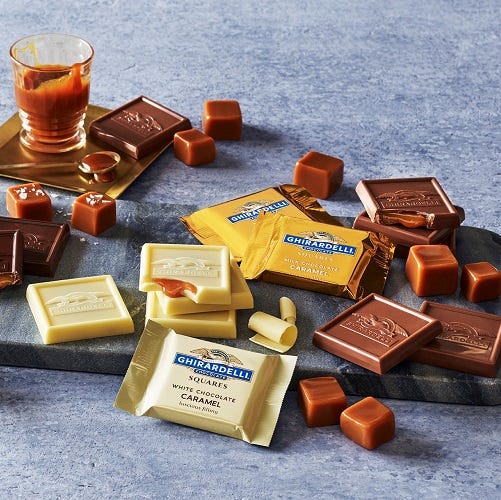

Is there gluten in Ghirardelli products?
-
We are pleased to let you know that many of our products are made without gluten-containing ingredients, such as our 60%, 72%, 86%, and 92% cacao bars and squares. In addition, you can feel confident that our baking chips and baking bars are also made without gluten-containing ingredients.
-
Gluten may be found in several premium chocolate products that Ghirardelli Chocolate Company produces; either as a glucose (wheat) or a barley component. It is also possible that a Ghirardelli Chocolate Company product is labeled with a “may contain wheat” precautionary allergen statement.
- Exact ingredients are listed on the label of each package. For consumers who are sensitive to gluten, we recommend reviewing the ingredient statement on all Ghirardelli products before consuming and to consult with your doctor.
Are Ghirardelli products non-GMO?
-
We can assure you Ghirardelli branded products, typically purchased in retail stores, meet non-GMO* standards. Food service products used in bakeries and restaurants also meet the non-GMO* standards.
*excludes baking mixes and sauces
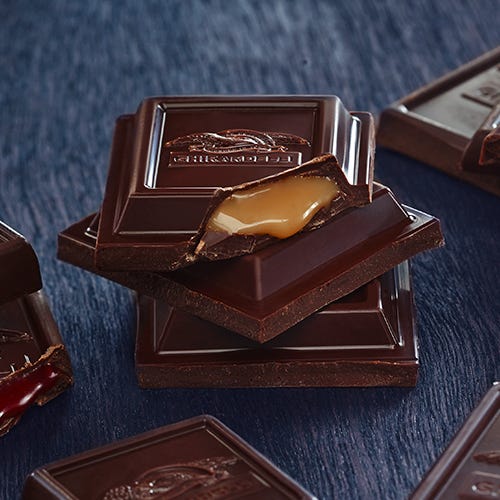

What is the cocoa content in your products?
- Most of our products do list cacao percentages right on the package. For the products that do not, however, the typical cocoa percentage is about 50%.
Do you use peanut/tree nuts in the manufacturing of your products?
- Ghirardelli Bars and Squares are made in a facility and on shared equipment with products containing the following tree nuts: almonds, pecans, hazelnuts, cashews and coconut.
- Ghirardelli chocolate chips (60% Bittersweet, Semi-Sweet, Mini Semi-Sweet and Milk Chocolate) are not produced on shared equipment that run tree nuts However, our chips are produced in the same facility that produce tree nut containing products.
- Peanuts are not used in the manufacturing facility for Bars, Squares, Chocolate Chips
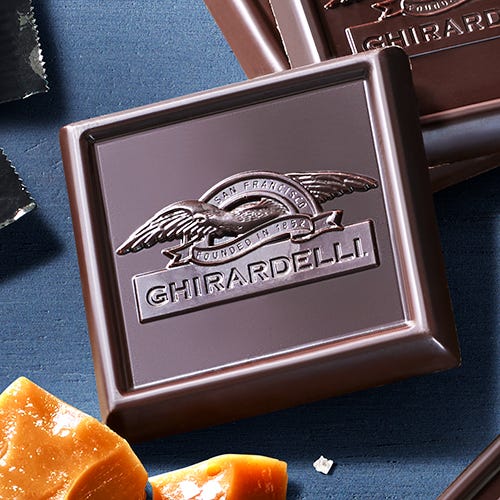

What is the gelatin source?
- Ghirardelli Chocolate Company is no longer using gelatin in the production of our products.
What is the caffeine level in your products?
- Caffeine is a compound naturally found in commonly consumed items such as coffee, tea, and chocolate. An average cup of coffee (8 fl oz) contains about 95 mg and the same amount of tea contains about 26 mg. Compared to these two sources chocolate has very little caffeine. The caffeine content of chocolate is dependent on the amount of cacao in the product. Dark chocolate contains about 20 mg of caffeine per ounce, milk chocolate contains about 6 mg per ounce, and white chocolate contains no caffeine. However, caffeine content will vary and can be dependent on the cocoa bean type and origin.


Can you make limited editions year round?
- Limited Edition flavors are only available for a certain times during the year. The Limited Edition program allows consumer to have a variety of tasty treats throughout the year, in addition to our standard line up of fine products.
Why has my favorite flavor been discontinued?
- Based on national sales we make tough decisions on discontinuations. However, feedback on the flavors is also appreciated and taken into account in future product developments.


Chocolate Substitutions
When you're baking and you need to substitute one Ghirardelli product for another, try these options
- Ghirardelli Bittersweet and Semi-Sweet Chocolate can be used interchangeably.
- Ghirardelli Unsweetened Chocolate and Ghirardelli Chocolate Semi-Sweet Baking Bars: 4 ounces of Ghirardelli Semi-Sweet Chocolate equals 2 ounces of Ghirardelli Unsweetened Chocolate combined with 2 ounces of sugar.
- Ghirardelli Unsweetened Premium Cocoa and Ghirardelli Sweet Ground Chocolate and Cocoa: For each ½ cup of Unsweetened Premium Cocoa, use 1 cup of Sweet Ground Chocolate and Cocoa and decrease the amount of sugar the recipe calls for by ½ cup.
- Ghirardelli Sweet Ground Chocolate and Cocoa and Ghirardelli Unsweetened Premium Cocoa: For 1 cup of Ghirardelli Sweet Ground Chocolate and Cocoa, use ½ cup Unsweetened Premium Cocoa and ½ cup sugar. Mix together prior to adding to the recipe.
- Ghirardelli Unsweetened Chocolate and Unsweetened Premium Cocoa: For every 1 ounce of Unsweetened Chocolate called for in a recipe, use 3 level tablespoons of Unsweetened Premium Cocoa and 1 tablespoon extra of butter, margarine, or vegetable shortening than called for in the recipe.
- Ghirardelli Sweet Ground Chocolate and Cocoa and Ghirardelli Unsweetened Baking Chocolate: For every 1 ounce of Ghirardelli Unsweetened Baking Chocolate, use 6 level tablespoons of Sweet Ground Chocolate and Cocoa; add 1 tablespoon extra of butter, margarine, or vegetable shorting than called for in the recipe; and decrease the amount of sugar the recipe calls for by 3 level tablespoons.
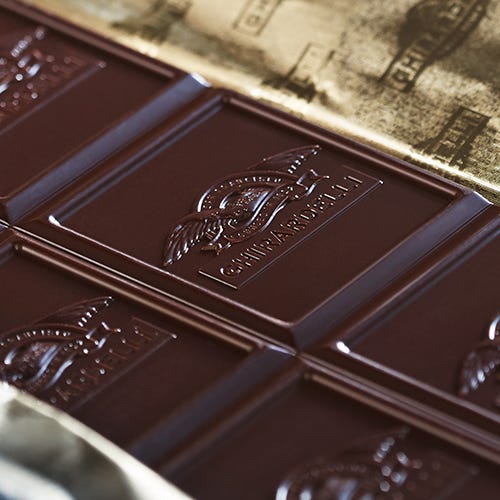

Chocolate Storage & Care
Love your premium-quality Ghirardelli Chocolate and it will love you back. Our experts share a few ins and outs for the storage and care of this special product, ensuring you enjoy your chocolate at the peak of it flavor and quality.
- Keep chocolate tightly wrapped and store in a cool, dry place at 60–75°F.
- Poor storage conditions will cause chocolate to "bloom," or develop a light-colored powdery surface on the chocolate, caused by sugar or fat crystals rising to the surface. When this happens, the chocolate will still be fine to eat, but the texture will suffer.
- To prevent bloom, make sure the chocolate doesn't get too warm or experience extreme fluctuations in temperature.


Where do our cocoa beans come from?
- Cocoa beans are the heart of our chocolates. Knowing which of the many different origins of cocoa beans will best contribute to the distinctive taste of a product is a skill that we have perfected over time. A fundamental distinction is made between consumer and fine flavor cocoa. Consumer cocoa is cocoa with a robust flavor. It accounts for the largest share (90-95%) of total global cocoa production and is farmed mainly in West Africa. Lindt & Sprüngli uses Forastero beans (consumer cocoa) from Ghana. The remaining 5-10% of worldwide cocoa harvests are fine flavor cocoa. Fine flavor cocoa is a high-quality cocoa with nuanced, fine aroma. It is mainly farmed in Latin America and the Caribbean. Lindt & Sprüngli uses fine flavor cocoa beans (Criollo and Trinitario) from Ecuador, Madagascar, Dominican Republic, Papua New Guinea and Peru. Our own sustainability program, the Lindt & Sprüngli Farming Program, is in place in all countries we source cocoa beans from.
- After achieving our goal to source 100% of our cocoa beans through the Farming Program in 2020, we extended the Farming Program to include cocoa butter from Côte d’Ivoire in 2021. These are major steps towards our target to source all of our cocoa products (beans, butter, powder, and chocolate mass) through sustainability programs by 2025. Learn more.


What is Ghirardelli doing with regards to sustainable sourcing of cocoa beans?
- In 2008, we launched the Lindt & Sprüngli Farming Program in Ghana and in the subsequent years in all our other cocoa bean sourcing origins (Ecuador, Dominican Republic, Madagascar, Papua New Guinea and Peru) to support cocoa farmers, their families and communities. The three main objectives are to increase the resilience of farming households, reduce the risk of child labor, and conserve biodiversity and natural ecosystems. Find out more here.
Is Ghirardelli using palm oil and is it sourced sustainably?
-
Palm oil, palm kernel oil, and their fractions are used in limited amounts in certain fillings of our chocolate. Lindt & Sprüngli buys less than 0.01% of the global palm oil harvest. While these products are important for their melting properties and for providing a neutral flavor, their production under uncontrolled conditions may be associated with environmental and social sustainability issues, including deforestation and conversion of peatlands, biodiversity loss, exploitation of workers, and adverse effects on local communities and Indigenous Peoples. However, palm oil can be produced responsibly when planted in suitable areas and with appropriate consideration for the environment and communities.
-
Palm oil is a high yielding vegetable oil. In comparison to soybean, rapeseed and sunflower, palm oil needs significantly less land to produce the same volume. We recognize that banning and substituting palm oil with other crops would require more land to be dedicated to vegetable oil production globally, likely at the expense of natural forest land. We believe that the best way to protect and restore the rainforest and threatened habitats is to undertake actions for a more sustainable palm oil industry. For these reasons, we only purchase palm oil certified according to the Round Table of Sustainable Palm Oil (RSPO) [TK1] sustainable standard (in Europe: RSPO’s Segregated traceability level; in US: mix of “Segregated” and “Mass Balance”), and always declare palm oil use on our product packaging. Find out more here.
Vocabulary
Alkalized or Dutch Processed Cocoa Powder - Cocoa powder that has been chemically treated (usually with potassium carbonate) to reduce acidity. See Cocoa Powder.
Aroma - The variety of scents given off by individual chocolate. Hold different kinds of chocolates to the nose and you'll quickly see that each has an individual and distinctive aroma.
Bittersweet Chocolate - Dark chocolate that contains a minimum of 35% chocolate liquor and less than 12% milk solids. Bittersweet and semi-sweet both fall under this definition; however, bittersweet is often the term used for chocolate with a minimum of 50% chocolate liquor.
Cacao - The defining ingredient in all chocolate and chocolate products. The term "cacao" refers to the tree and its fruit and the seeds (otherwise known as cocoa beans) inside the fruit, which are processed to make chocolate.
Varieties of Cacao
- Forastero: The hardiest and most productive of the three or four cacao varieties, Forastero is believed to have originated in the Amazon basin. Today it is grown around the globe and accounts for over 90% percent of the world's cacao. Chocolate manufacturers value Forasteros for basic robust chocolate flavor.
- Criollo: Considered the rarest and most prized of the three or four recognized varieties of cacao, Criollo is native to either northern South America and or Mesoamerica. Prized for their fragrance and delicate and complex flavor, criollos are "flavor beans" which account for less than 1% of the world's cacao.
- Trinitario: One of three or four recognized varieties of cacao, Trinitario is a hybrid of the flavorful Criollo and hardy Forastero. Along with Criollos, Trinitarios are considered "flavor beans" and they account for less than 5% of the world cacao crop.
- Nacional or Arriba: The proposed fourth variety of cacao from Ecuador, otherwise considered a finer strain of Forastero.
- Theobroma Cacao: The botanical name for the tree, fruit, and seeds from which chocolate is made.
Cacao Beans/Cocoa Beans Seeds from the pod of a Theobroma tree. Native to the dense tropical Amazon forests. Commercially grown worldwide in tropical rainforests within 20° latitude of the equator.
Cacao Content - Cacao content refers to the amount of the chocolate product that is made of the three cacao components (chocolate liquor, cocoa butter and cocoa powder).
Chocolate Liquor - The ground up center (nib) of the cocoa bean (otherwise known as unsweetened chocolate and is often used in baking) in a smooth, liquid state. It contains no alcohol.
Chocolate Truffle - A rich confection made from chocolate and cream (ganache), although it may contain butter, eggs, and other flavorings. Truffles may be dipped in chocolate and or rolled in cocoa powder. Although American-style chocolate truffles are larger and may be decorated, the original European chocolate truffle is bite-sized with a rough cocoa-y exterior.
Cocoa - The term cocoa is used in different ways. When it appears on a chocolate label with a percentage, it denotes the total cocoa bean (cacao) content of the chocolate and the term is sometimes used interchangeably with chocolate liquor, cacao, cocoa beans or cocoa solids. Not to be confused with Cocoa Powder.
Cocoa Butter - The unique ivory colored fat that constitutes 50 to 54% of roasted cocoa beans. Cocoa butter has little flavor of its own, but it adds considerable richness and depth to the flavor of chocolate. Cocoa butter makes chocolate fluid when melted and crisp when hardened. Chocolate melts readily and luxuriously on the tongue because cocoa butter melts at body temperature. Cocoa butter contributes to the creamy smooth texture and the long finish that characterizes fine chocolate.
Cocoa Mass or Cocoa Masse - An alternate term for the total cocoa bean, cacao, chocolate liquor, or cocoa content of chocolate.
Cocoa Nibs - Pieces of hulled, roasted cocoa beans. Nibs are composed of fat called cocoa butter (50%-54%) and non-fat dry solids fat (46%-50%).
Cocoa Powder - Used as an ingredient in baking, or the base for a hot beverage. Cocoa powder is chocolate liquor, which has been pressed to remove most of its fat, and then pulverized to a powder. High fat cocoa powders typically contain 22%-24% cacao fat; low-fat cocoa powders typically contain 10% or less cacao fat.
Natural Cocoa Powder - Cocoa powder that has not been "Dutch" processed or treated with chemical alkali
Compound - Known as confectionery coating. A blend of sugar, vegetable oil, cocoa powder, and other products. Vegetable oil is substituted for cocoa butter to reduce the product cost and to make the coating easier to work with.
Conching - Conching is the prolonged heating, mixing and scraping or grinding process done during the last stages of chocolate manufacture. Conching produces both a smooth texture by reducing the size of the particles and mixing them, and a smooth flavor by driving off unwanted harsh flavors and aromas.
Couverture - Chocolate with a minimum of 32% cocoa butter. Most couverture these days contains even more than 32% cocoa butter! Dark Chocolate See Sweet Chocolate below.
Dry or Non-Fat Cocoa Solids - The non-fat portion of the cocoa bean.
Dutch Process - A treatment used during the making of cocoa powder in which cocoa solids are treated with an alkaline solution to neutralize acidity. This process changes the color of the cocoa and develops a milder chocolate flavor.
Fat Bloom - The result of inadequate tempering or temperature abuse of a properly tempered chocolate. Visible as a dull white film on the surface of the chocolate with the possibility of a soft or crumbling texture on the interior. It is a visual and textural defect only. The product is fine to eat.
Ganache - A mixture of chocolate and cream used as the filling for chocolate truffles, but also for sauces, glazes and cake fillings.
Gloss - The satiny sheen or mirror-like shine on the surface of a perfectly tempered piece of chocolate.
Lecithin - A natural emulsifier added to chocolate to promote fluidity when the chocolate is melted. The lecithin used in chocolate manufacture is derived from soy.
Milk Chocolate - Chocolate with at least 10% chocolate liquor, 12% milk solids and 3.39% milk fat, combined with sugar, cocoa butter, and vanilla. Mouthfeel The texture of a substance in your mouth; how the chocolate feels as it melts on your palate.
Nib - The center (meat) of the cocoa bean. When ground, the nib becomes chocolate liquor.
Note The variety of distinctive flavors or hints of flavor that one can pick up when tasting and appreciating an individual piece of chocolate. Chocolate, like fine wine, has a flavor profile that's very individual. It's common to pick up hints of smoke, coffee, cherry, vanilla, nuts or citrus in chocolate. Further, no two people will necessarily pick up the exact same notes in chocolate, depending on their experience savoring chocolate.
Percentage - The percentage label on chocolate bars indicates the total amount of the bar, by weight, comprised of cocoa beans (including added cocoa butter or dry cocoa solids). Dark chocolate generally features a higher percentage of cacao than milk chocolate.
Semi-Sweet Chocolate - Also known as bittersweet chocolate. Contains a minimum of 35% chocolate liquor and less than 12% milk solids.
Snap - The sound and the feel of chocolate as it breaks or is bitten. A sharp, crisp snap indicates fine particle size, high quality cocoa butter, and good tempering. Dark chocolate generally has more "snap" than softer milk chocolate.
Sugar Bloom - Visible as a dull white film on the surface of the chocolate. Dry and hard to the touch, sugar bloom is the result of surface moisture dissolving sugar in the chocolate and subsequent recrystallization of the sugar on the chocolate surface. Typically caused by cold chocolate being exposed to a warm humid environment with resultant condensation forming on the product. It is a visual and textural defect only. The product is fine to eat.
Sweet Chocolate (Dark) - Chocolate that contains a minimum of 15% chocolate liquor and less than 12% milk solids with varying amounts of sweeteners and cocoa butter.
Tempering - A process of preparing chocolate that involves cooling and heating so that it will solidify with a stable cocoa butter crystal formation. This process is used to prepare chocolate for coating and dipping. Proper tempering, followed by good cooling, is required for good surface gloss and to prevent "fat" bloom.
Unsweetened Chocolate - Same as "chocolate liquor." The chocolate liquor is cooled and molded into blocks that can be used for baking. White Chocolate Contains at least 20% cocoa butter, 14% milk solids, and 3.5% milk fat. It contains sugar, cocoa butter, milk solids and fats, and flavorings. White chocolate is white because it contains no cocoa powder or chocolate liquor/unsweetened chocolate.
White Confectionery Coating - Although apparently similar to white chocolate, white confectionery coating contains no part of the cocoa bean. It is made with sugar, milk and milk fat, vanilla, lecithin, and vegetable fats.
Chocolate Questions & Answers
What does the percentage of cacao content mean?
- Cacao content refers to the total cacao content in the chocolate, which is everything derived from the cocoa bean. The three cocoa components are: chocolate liquor, cocoa butter and cocoa powder.
- For example, in our 60% Cacao Dark Chocolate SQUARES Chocolate, the 60% cacao content is made up of cocoa butter and chocolate liquor with the remaining 40% made up of sugar, vanilla, and other ingredients.
Is higher cacao content always better?
- Not necessarily. The cacao content gives an indication of how intense or how sweet the chocolate will be. The preference for higher cacao content chocolate may change from person to person or from time to time.
- For example, one moment you may prefer the 60% Cacao Dark Chocolate SQUARES Chocolate while another you may prefer 72% Cacao Twilight Delight Intense Dark Chocolate, depending on whether you want something more sweet or more intense.
- Ghirardelli has a 100% Cacao Unsweetened Baking Bar. While this is the highest cacao content possible, it is for baking, not eating since it is very bitter and has absolutely no sugar added.
When I look across brands, can I compare Ghirardelli's 60% Cacao Dark Chocolate with other companies' 60% Cacao Dark Chocolate?
- Not necessarily. Since cacao content can be comprised of any one of the three cocoa bean components, the flavors may be very different. A chocolate made from more cocoa powder may not achieve as an intense chocolate flavor. Ghirardelli achieves 60% cacao content without using any cocoa powder.
- Additionally, Ghirardelli's process of hand-selecting the world's finest cocoa beans and roasting them to perfection ensures an intense chocolate flavor. Other brands with similar cacao content may not be as selective in their roasting process to get the same intense chocolate flavor.
Why do I need to know the cacao percentage?
- Knowing the cacao percentage will help you select the chocolate to satisfy your craving. Since higher cacao content chocolate is less sweet with a more intense chocolate flavor, knowing the cacao content will help you select the perfect chocolate for you.
- Cacao content is also important when pairing with other foods and beverages. Find out more about Chocolate Pairings. For baking chocolate, knowing the percentage allows you to control the sweetness and chocolate intensity in your baked goods.
Is cacao percentage the main indicator of quality?
- While cacao percentage will determine the intensity of the chocolate, the quality of chocolate is also affected by many other factors including:
- Quality and selection of cocoa beans
- Roasting process
- Grinding, blending, and conching processes
- Technology employed in the chocolate making process
- Quality of other ingredients (for example, vanilla vs. vanillin)
- Experience in chocolate making
- Ghirardelli's process of hand-selecting the world's finest cocoa beans and roasting them to perfection ensures an intense chocolate flavor. Other brands with similar cacao content may not be as careful in their bean selection, roasting, or manufacturing process, yielding a lower quality product. Find out more about the Ghirardelli Difference
What is the difference between "cacao" and "cocoa"?
- Historically, "cacao" and "cocoa" were used interchangeably since "cocoa" is easier to understand. However, technically, "cocoa" should be used in referenced to powder products, while "cacao" should be used when referring to the bean, which yields the cacao components - chocolate liquor, cocoa butter and cocoa powder.
When I look at another brand's products, it says "Chocolate Flavor." What does that mean?
- Some other brands don't use real chocolate in their products, so by regulation, they cannot be labeled as chocolate. Ghirardelli uses real chocolate in its products.
Is a bean blend or single origin better?
- The proprietary blend of bean varieties allows Ghirardelli to achieve a specific Ghirardelli taste that is consistent year after year. With single origin chocolate, the flavor may vary from year to year based on the crop of beans that year. Ghirardelli uses a proprietary blend of bean varieties that has been refined over the company's 150-year history to provide the company's distinct and intense chocolate taste. The exact source of the beans is a closely held family secret.
Is chocolate with higher cacao content darker?
- Yes, in general, darker chocolate and higher cacao content chocolate mean the same thing – more intense chocolate taste and higher percentage of cacao components, although the definition of dark chocolate is very broad.
- With Ghirardelli chocolate, higher cacao content means that the chocolate tastes darker, has more intense chocolate flavor, and has less sugar. However, when comparing across brands, higher cacao content may not mean darker since a chocolate made from more cocoa powder may not achieve as an intense chocolate flavor. Also, other brands with similar cacao content may not be as selective in their roasting process to get the same intense chocolate flavor.
What are some ways to entertain with chocolate?
How should I taste chocolate?
I just opened a chocolate bar and the chocolate is dry with white spots on it. What is this?
- Most commonly, this is "bloomed" chocolate. Chocolate bloom occurs when chocolate has been exposed to wide changes in temperature. Although it may look unpleasant, bloomed chocolate is not harmful to eat.
What is "dutched" cocoa?
- Dutched cocoa means the cocoa underwent a process that results in milder chocolate flavor notes by reducing acidity. The dutching process can also change the color from light red to brown to black. Dutched cocoa works well in chocolate items such as devil's food cake or brownies.
What is cocoa butter?
- Cocoa butter is a natural fat that is present in cocoa beans. It is obtained by pressing the unsweetened chocolate, or "chocolate liquor." Cocoa butter is not a dairy product as is sometimes thought.
What is soy lecithin?
- A natural emulsifier derived from soybeans, which is added to chocolate to help maintain an emulsion between the cocoa butter and sugar.
Is chocolate liquor alcohol?
- Chocolate liquor is the ground up center (nib) of the cocoa bean (otherwise known as unsweetened chocolate) in a smooth, liquid state. It contains no alcohol.
How should chocolate be stored?
- Chocolate should be kept wrapped tightly in a cool, dry place with a temperature ranging from 60-75°F. If the storage temperature exceeds 75°F, some of the cocoa butter may appear on the surface, causing the chocolate to develop a whitish cast, known as "bloom." The chocolate will still, however, be fine to eat. In hot climates or during the summer, chocolate can be stored in the refrigerator, although this isn't ideal as the chocolate may absorb odors from other foods. Dark chocolate actually improves with age, like a fine wine, if stored in an airtight container at 60-65°F.
What is Ghirardelli's stance on the proposal to change the definition of chocolate?
- Ghirardelli does not support the changing the "standard of identity" or "definition" of chocolate. As you may have heard, the FDA is considering changing the "standard of identity" for chocolate. These changes (proposed by other chocolate manufacturers) would allow for the addition of vegetable oil in place of cocoa butter without losing the ability to call the product Milk Chocolate, Semi-Sweet Chocolate or Bittersweet Chocolate. This substitution is not allowed today unless manufacturers clearly label their products as "chocolaty", "chocolate flavored", sweet chocolate and vegetable fat coating, or milk chocolate and vegetable fat coating.
- If the proposed changes are approved, consumers would have no idea by reading the front of the label whether the traditional milk, semi-sweet or bittersweet chocolate are suddenly made with other vegetable fats rather than the cocoa butter that they have come to expect.
